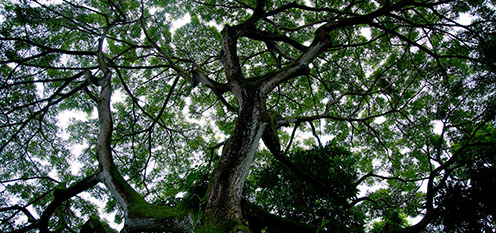Defaunation – overlooked in international forest governance - jeopardises forest carbon storage and climate change mitigation efforts
Empirical studies across the tropics have shown that defaunation (i.e., the human-induced extinction of large and medium-sized mammals) can have cascading effects on forest structure and dynamics.

The role of fauna in forest ecology and unsustainable hunting have important consequences that are left out in contemporary forest governance discussions, including REDD+. Forest fauna perform many ecological functions, directly and indirectly influencing ecosystem processes including pollination, seed dispersal and affecting germination, plant regeneration and growth, and biogeochemical cycles. Empirical studies across the tropics have shown that defaunation (i.e., the human-induced extinction of large and medium-sized mammals) can have cascading effects on forest structure and dynamics.
Hunting leading to defaunation may reduce forests carbon storage capacity
The sustainability of hunting is questionable in many locations, and particularly larger species are rapidly depleted when hunting supplies urban markets with meat from wild animals. Removing large animals that are the primary dispersers of large-seeded trees increases the likelihood of extinction for large-seeded tree species that on average have a slightly higher wood density than small-seeded trees. This potentially erodes forest carbon storage capacity, and there is increasing evidence suggesting that the long-term effect of hunting and defaunation on forest carbon storage capacity can undermine REDD+ climate change mitigation efforts.
Krause and Nielsen assessed to which extent the link between defaunation and carbon storage capacity was addressed in contemporary forest governance decisions, policies and project documents focusing on REDD+.
Oversight – or delibirate choice to ease negotiations?
The study finds that the higher-level policy documents as well as sub-national project plans to some extent did address biodiversity, fauna, and hunting. However, hunting and defaunation as a driver of forest degradation and the link between fauna and forest ecosystem function were not mentioned in international or national level documents. Rather than an oversight, this may represent a deliberate political choice to avoid adding further complexity to REDD+ negotiations and implementation. This may be attributed to resistance to accepting the transaction costs of taking on these additional “add-ons” in a REDD+ negotiation process, readiness, and implementation phase that has already been complex and lengthy.
“Although biodiversity has moved from a side issue to an inherent feature in REDD+ discourses, decisions, and national programmes over the last decade, we show that the ecological functions of biodiversity are still only mentioned superficially,” says Torsten Krause, Associate Senior Lecturer at Lund University Centre for Sustainability Studies in Sweden. “At the sub-national level, fauna and hunting were much more likely to be mentioned in project documents but we still found no explicit mentioning of a link between defaunation and carbon storage capacity”.
Necessary to challenge assumptions
Hence, the study presents evidence that defaunation as an important factor in forest degradation is virtually overlooked in international climate negotiations and forest governance. “The assumption that forest cover and habitat protection equal effective biodiversity conservation is misleading, and must be challenged,” says Martin Reinhardt Nielsen, Associate Professor at Department of Food and Resource Economics at University of Copenhagen, Denmark. “The fact that defaunation and particularly the loss of large seed dispersers through unsustainable hunting have lasting repercussions throughout the forest ecosystem, decreasing tree diversity, carbon storage and overall forest resilience, must be acknowledged and considered in REDD+ as an international mechanism and for forest governance to be viable in the long term”.
Krause and Nielsen concludes that “Biodiversity and fauna monitoring, as well as hunting management, must be built explicitly into national and project level monitoring, reporting, and verification methods. Otherwise, there is a risk that we lose the forest for the trees.”
Link to full paper: Not Seeing the Forest for the Trees: The Oversight of Defaunation in REDD+ and Global Forest Governance
Notes
Krause and Nielsen conducted a desk study searching relevant international decisions on forests by the conferences of the parties to the UNFCCC and recent national REDD+ strategies and programme documents. Krause and Nielsen analysed 49 national REDD+ documents (e.g., national REDD+ strategies, and National Programme Documents) in 20 countries. Finally, sub-national REDD+ project documents for verified REDD+ projects in Colombia, Ecuador, Nigeria, Tanzania and Indonesia were analysed.
Topics
Related News
Contact
Martin R. Nielsen
Associate Professor
+45 22 28 08 47
+45 35 33 17 26
mrni@ifro.ku.dk
